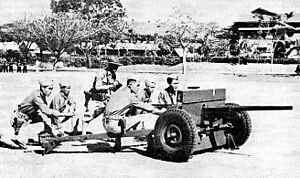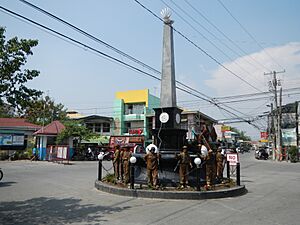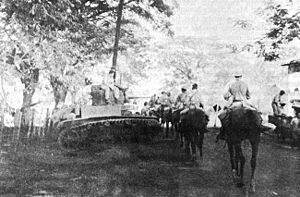Philippine Scouts facts for kids
Quick facts for kids Philippine Scouts |
|
|---|---|

Philippine Scouts shoulder sleeve insignia from 1921–1947 was the head of the carabao (water buffalo) which symbolized the Philippines. The colors red and gold represented the islands' Spanish colonial roots.
|
|
| Active | 1901–1948 |
| Country | |
| Allegiance | (1901–1946)
(1946–1948) |
| Branch | Philippine Division |
| Colors | red and gold |
| Mascot(s) | Carabao |
| Engagements | Philippine–American War Moro Rebellion Palawan Uprising World War II |
The Philippine Scouts (in Filipino: Maghahanap ng Pilipinas) were a special military group. They were part of the United States Army from 1901 until after World War II. Most of these soldiers were Filipinos or Filipino-Americans.
They served under American officers in the United States Army's Philippine Department. Some Filipino-Americans even became officers after training at the United States Military Academy. Their units often had "(PS)" added to their names to show they were Philippine Scouts.
The U.S. first created Scout companies in 1901. Their job was to fight the Philippine Revolutionary Army. Later, these companies became full regiments within the U.S. Army. They included infantry, artillery, and cavalry units. These Scouts became the main U.S. Army troops in the Pacific region.
The Philippine Scouts also helped bring peace to the islands. They worked to calm the Moro tribes on Mindanao island. They also saw action in Jolo, Palawan in the 1930s. The Philippine Scout regiments were the first U.S. Army units to fight in World War II. They fought until the USAFFE surrendered in May 1942. Even after that, some Scouts kept fighting against the Japanese. They became part of the resistance movement.
Contents
Early Beginnings: Macabebe Scouts
| Macabebe Scouts | |
|---|---|
| Active | 1899–1901 |
| Country | (1899–1901) |
| Allegiance |
|
| Branch | |
| Type | Militia, Irregulars |
| Role | intelligence, reconnaissance |
| Size | 1,402 personnel in December 1900 |
| Engagements | Philippine–American War Moro rebellion |
| Commanders | |
| Notable commanders |
General Henry Lawton General Frederick Funston |
Before the main Philippine Scouts, there were the Macabebe Scouts. These were local guides and former Spanish Army soldiers from Macabebe. They joined U.S. forces in 1899. They were very helpful to the U.S. Army.
The Macabebe Scouts were known for their loyalty. They even helped capture General Emilio Aguinaldo, a key leader of the Philippine Revolutionary Army. This event made them famous.
In 1901, the U.S. Army officially allowed the creation of native Scout units. President Theodore Roosevelt approved a unified group of 5,000 men. These new Scouts quickly earned praise from their American commanders.
Philippine Scouts and World War II
In July 1941, as war approached, President Roosevelt called General Douglas MacArthur back to duty. He put MacArthur in charge of the United States Army Forces in the Far East (USAFFE). This group included all military forces in the Philippines, except the U.S. Navy.
The Philippine Division and all Philippine Scout units became part of USAFFE. At that time, USAFFE had over 22,500 troops. Almost 12,000 of them were Philippine Scouts. Most of the Philippine Division's enlisted men were Philippine Scouts.
Filipino Officers in 1941
The U.S. Army started sending talented Filipino soldiers to West Point in 1910. Some famous graduates included Vicente Lim and Fidel V. Segundo. By 1941, some of these men were high-ranking officers. Some even joined the Philippine Commonwealth Army. In July 1941, fifteen Filipino Scout officers served in the Philippine Division.
Fighting in World War II
On December 7, 1941 (December 8 in Asia), Japan attacked Pearl Harbor and the Philippines. Over the next few months, Japan took over many countries in the Pacific. But the Philippines held out.
On the Bataan Peninsula of Luzon Island, the Philippine Scouts, along with U.S. and Philippine Army soldiers, bravely fought the Japanese. They held out for over four months. Many survivors said the Philippine Scouts were the strongest part of the American defense.
President Franklin Roosevelt gave the first three Medals of Honor of World War II to Philippine Scouts. These went to Sergeant Jose Calugas, Lieutenant Alexander R. Nininger, and Lieutenant Willibald C. Bianchi. They all showed incredible bravery in battle.
The soldiers on Bataan faced huge challenges. There was not enough food, medicine, or ammunition. They were often fed only half rations. This was not enough for men fighting in the tropical heat. Many suffered from malaria, dysentery, and hunger. Despite this, they kept fighting.
Prisoners of War
The Battle of Bataan ended on April 9, 1942. Major General Edward P. King, Jr. surrendered to save his starving soldiers. About 70,000 men became prisoners of war (POWs). This included about 16,000 Americans and 54,000 Filipinos.
The Japanese forced these prisoners to march sixty-five miles. This terrible journey became known as the Bataan Death March. Many prisoners died during the march from exhaustion, hunger, or violence. Japanese guards often shot those who fell or tried to get water.
The march ended at a railroad station. The POWs were then crammed into train cars. They were taken to Camp O'Donnell, a prison camp.
Life in Camp O'Donnell
At Camp O'Donnell, conditions were very bad. The camp was designed for 10,000 men, but 60,000 prisoners were forced into it. There was little water, food, or medical care. Diseases like malaria and dysentery spread quickly. Prisoners died at a rate of about four hundred per day.
From September to December 1942, the Japanese slowly released the Filipino prisoners. They sent them back to their families. But by January 1943, 26,000 of the 50,000 Filipino prisoners had died at Camp O'Donnell.
The American prisoners were moved to Cabanatuan. Conditions were slightly better there. But as U.S. forces got closer to the Philippines in 1944, the Japanese moved the healthiest American prisoners to Japan and Manchuria. They were forced to work as slave laborers. Many died during these transfers or in the work camps. By the end of the war, two-thirds of the American prisoners had died in Japanese custody.
After the War: Liberation and New Scouts
During the Japanese occupation, a strong Filipino guerrilla movement grew. Some of these groups were led by escaped American officers. They included former Philippine Scouts and Philippine Commonwealth Army soldiers.
When General MacArthur's forces returned to liberate the Philippine Islands, the surviving Philippine Scouts rejoined the U.S. Army. Many guerrillas also joined them. The U.S. Army created new Philippine Scout units. The old Philippine Division became the 12th Infantry Division.
These "New Scouts" fought bravely against the Japanese in northern Luzon. They also helped restore order and find remaining Japanese soldiers. They even served as occupation forces in Okinawa. The Philippine Scouts were planned to be part of the invasion of Japan.
After Japan surrendered in August 1945, the United States gave the Philippines full independence on July 4, 1946. This created a unique situation for the Philippine Scouts. They were U.S. Army soldiers, but now citizens of a foreign country. To solve this, the U.S. offered them full U.S. citizenship. Many Scouts accepted and continued their military careers in other U.S. Army units.
In 1947, President Truman officially ended the Philippine Scouts as a U.S. Army group. All their unit flags were retired. The Philippine Scouts were finally disbanded in December 1948.
Lasting Legacy
Many former Philippine Scouts continued to serve the United States for many years. They fought in the Korean War, the Vietnam War, and during the Cold War. Their children often followed in their footsteps, becoming U.S. Army soldiers and Marines.
Two children of Philippine Scouts even became U.S. Army generals: Lt. General Edward Soriano and Major General Antonio M. Taguba.
For many years, veterans of the Philippine Division were not granted U.S. citizenship, unlike other non-citizen veterans. Since 1993, efforts have been made to fix this. In 2009, a law was passed that gave a one-time payment to these veterans or their spouses. However, this was still less than what other U.S. veterans received.
In 2012, a documentary film called Forgotten Soldiers was made. It told the story of the Philippine Scouts. The film received awards from various cities and film festivals. It helped bring their important story to light.
Notable Philippine Scouts
- Vicente Barros – Major, U.S. Army, an important Filipino officer.
- Vicente Lim - Brigadier General, the first Filipino to graduate from West Point.
- Mateo M. Capinpin - Brigadier General, led the 21st Division of the Philippine Army at the Battle of Bataan.
- Willibald C. Bianchi – First Lieutenant, U.S. Army. Received the Medal of Honor.
- Jose Calugas – Captain, U.S. Army. Received the Medal of Honor.
- Eddie Garcia – Sergeant. Later became a famous actor.
- Louis C. Mosher – First Lieutenant, U.S. Army. Received the Medal of Honor.
- Alexander R. Nininger – Second Lieutenant, U.S. Army. The first person to receive the Medal of Honor in World War II.
- José B. Nísperos – Private First Class, U.S. Army. The first Asian to receive the Medal of Honor.
- Juan Pajota – Captain, U.S. Army.
- Edwin Ramsey – First Lieutenant, U.S. Army. Led the last horse cavalry charge in U.S. military history.
- Benigno G. Tabora – Sergeant Major, U.S. Army. Received the Purple Heart.
- Miguel White – Lieutenant, Philippine Army. An Olympian.
- Teofilo Yldefonso – Sergeant, U.S. Army. An Olympian.
Images for kids






